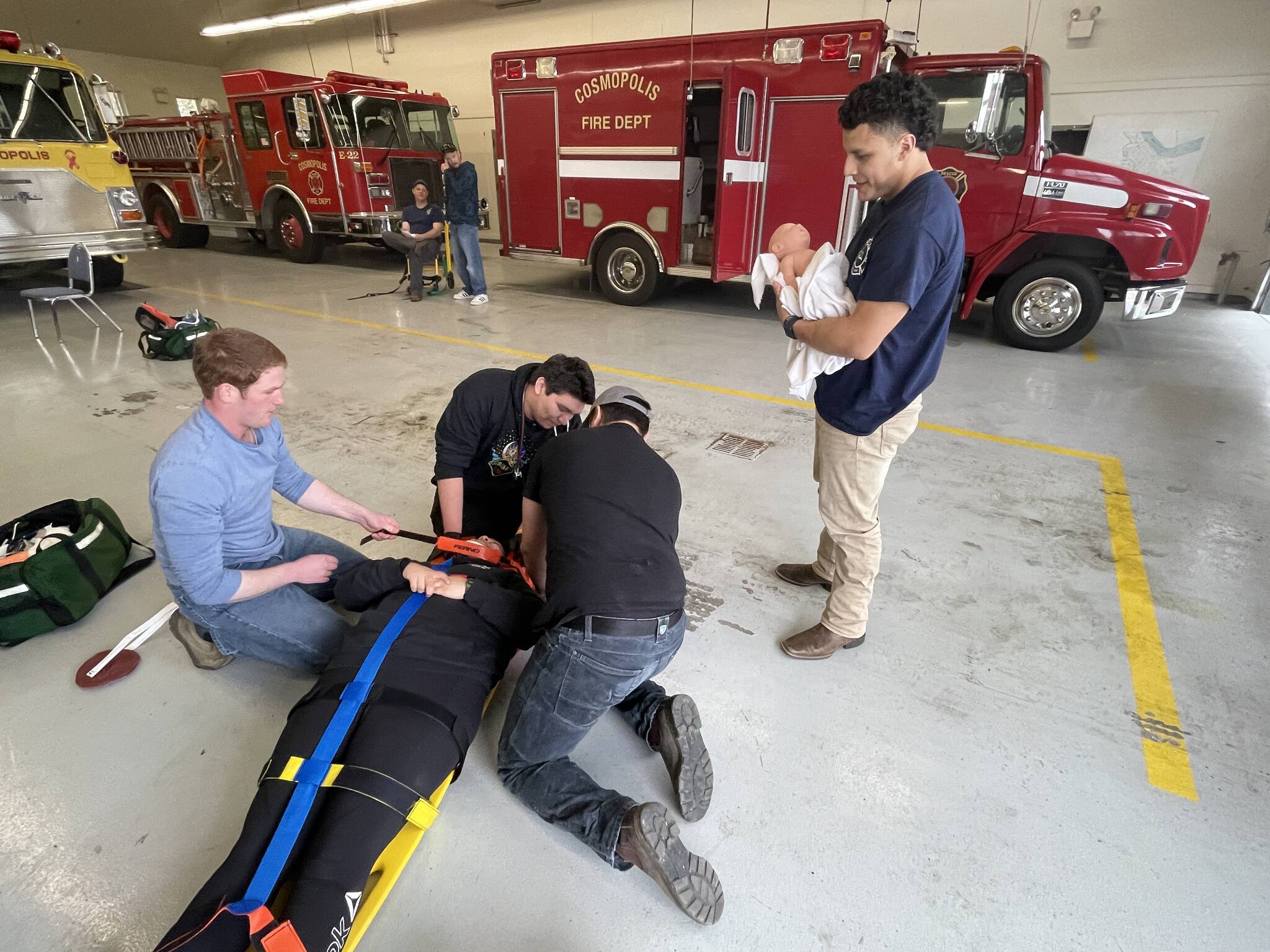The Cosmopolis Fire Department is a scene of trauma-splashed chaos: a woman pinned between two vehicles, a man slumped over a steering wheel, a body lying halfway underneath a pickup truck.
They’re an awful cheerful lot for nearly half a dozen casualties in various states of serious injury, though. Maybe their wounds being entirely simulated has left them in a good mood.
It’s a Saturday afternoon and the county’s emergency medical technician academy is giving its volunteer students a chance to practice hands-skills, extricating simulated casualties from in, on, and around automobiles, a technically demanding exercise.
“The trickiest part is learning how the system works. They all want to run in and help people,” said David Schrier, senior instructor for the course. “We can talk about it all we want in the classroom. But to see it happen is completely different.”
More than 20 volunteers came out on the drizzly Saturday to practice assessing scenes, triaging injuries and getting them to higher care. Instructors oversaw the training, critiquing responses and helping to set up the scenarios — some straightforward, like broken bones, and others that aren’t so simple.
“We’ve never pulled people out of cars before and backboard people out of cars. This is really prepping us for what we’re going to see in the field, hands on,” said Aaron Beach, a volunteer with Grays Harbor Fire District 2. “I didn’t think about having to deliver a baby right outside of a car before. That’s a real possibility.”
Delivering a baby, one of the possible medical situations students practiced for on Saturday, was an eye-opener for many going through the course.
“The baby, a little bit … that threw me off guard,” said Camilo Tobito. “You see it but not often.”
For many students, the chance to get out of the classroom and to practice the skills they were learning was a welcome one.
“I really enjoy the hands-on. I feel like I learn a lot more,” said Yamilie Castro, a volunteer with the Raymond Fire Department. “I want to be good at it. I don’t want to just learn it in the classroom.”
All firefighters are required to have at least an EMT certification, like the one provided the class.
“Whoever you’re thrown in, you rely on them to have a good base of knowledge and being able to work together,” said Dave Ehler, a volunteer with South Beach Regional Fire Authority. “If you have those two things, you can handle a lot of situations.”
All volunteers together
The volunteers in the class joined for a variety of reasons. Beach lived near the site of a bad car accident. Castro was crushed by a piece of machinery, and was saved by firefighters, and wanted to give back. Tobito has served as a volunteer firefighter elsewhere, and wants to help the community. Ehler was involved on the logistics side of emergency management elsewhere, and wanted to volunteer for more hands-on work.
It’s a worthy thing to do, Schrier said.
“It’s very admirable to put yourself in a position to be able to help others,” Schrier said. “To be paid or volunteer doesn’t even matter. The idea of sacrificing your time, your family, for the love of your neighbors, is admirable.”
Many departments are hurting for volunteers — the world, the society that made all-volunteer departments perfectly viable options decades ago, no longer exists.
“Our community in Raymond — we don’t have a lot of volunteers. The fire department is a big thing in our community,” Castro said. “Go for it. It’s a lot of fun. You learn a lot.”
If someone has questions about volunteering, Ehler said, the quickest way to find answers is to go down and ask.
“Jump in. Find a way. Just go talk to them,” Ehler said. “Find out about these people. Find out about what they know, what they do.”
Castro strongly encouraged residents to think about volunteering at their local departments.
“I think people should really volunteer. It’s really inspiring. You learn a lot of stuff from good people, good EMTs, good medics, good firefighters,” Castro said. “There’s always a way of doing the same abilities as men. It is hard for a woman to be in the fire service. We can overcome that as well.”
The class is wrapping up soon, Schrier said, as students are tested, memorizing pages of checklists for how to handle scenes until it becomes a reflex.
“I think the biggest surprise is how much they learn, or the camaraderie,” Schrier said of the volunteers. “When they start they’re strangers. They’re very close at the end of it.”
Contact Senior Reporter Michael S. Lockett at 757-621-1197 or mlockett@thedailyworld.com.



